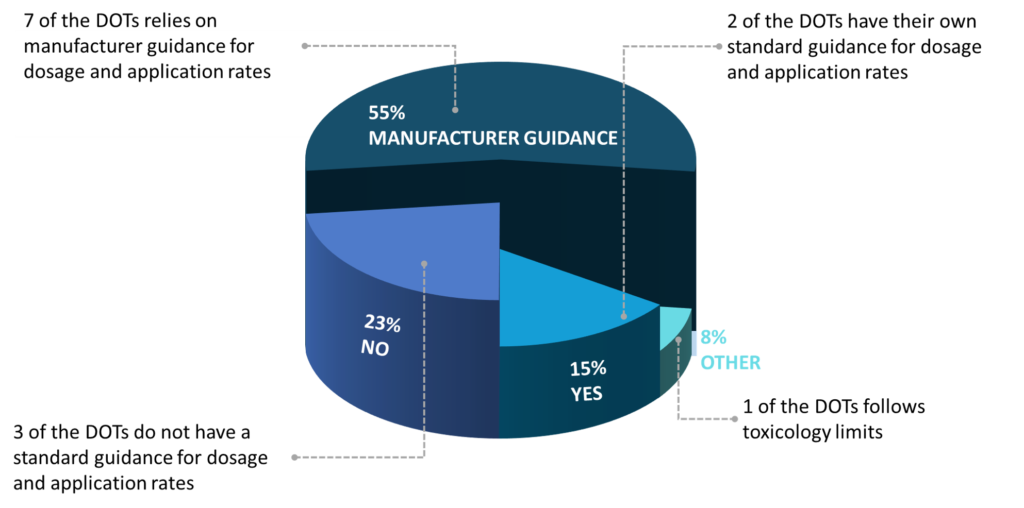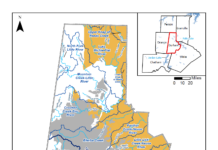By Billur Kazaz, MS, CPESC-IT; Michael A. Perez, Ph.D., CPESC; Wesley N. Donald, Ph.D., CPESC
Flocculants are an effective solution to improve the sediment capture performance of construction stormwater management practices. With the appropriate product selection, dosage and application, construction stormwater can be rapidly treated to remove fine-sized soil particles from suspension.1 This study investigates the use of flocculants for construction stormwater applications in the United States by presenting results from a state-of-the-practice survey. The survey was distributed to state departments of transportation (DOTs) to investigate current flocculant implementations on construction sites. The study highlights the perspective of state DOTs on using flocculants for construction stormwater treatment.

Use of Flocculants
Flocculants are water-soluble polymers that have been used by many different industry applications for solid-liquid separation purposes including water treatment, mining and construction stormwater management. Flocculation occurs as a result of a chemical process that binds small soil particles with a bridging mechanism and forms larger flakes that settle out of suspension.2 Construction stormwater management has shifted its focus on these chemical agents in a positive way for reducing erosion and treating sediment-laden runoff. Research studies show that these chemicals are highly effective in construction stormwater treatment with adequate application techniques and dosage recommendations.3-7 On the other hand, these chemicals have the potential to create risks for polluting water bodies and damaging aquatic life in case of an overdose and improper implementation.
The U.S. Environmental Protection Agency emphasizes the significance of proper dosage guidance and adequate application techniques in flocculant usage for minimizing pollution in downstream water bodies.8 Therefore, state agencies are cautious when integrating flocculants into their specifications for construction stormwater treatment. This research was performed to understand the current perspective of DOTs on flocculant selection, dosage and application guidance.
Survey Questions and Distribution
The survey was developed and delivered using an online survey platform with multiple-choice questions that primarily focused on identifying flocculant users and non-users among the DOT’s. Survey participants received questions based on their flocculant usage. Three questions were asked of the non-using agencies and up to ten questions were asked of flocculant users. Depending on their responses to questions, the survey would deviate into differing paths to ensure appropriate questions were asked. DOTs that integrate flocculants into their construction stormwater management specifications received detailed questions on usage purpose, approved flocculant types by their state, dosage and application guidance, and residual monitoring.
The survey was distributed to lead construction stormwater professionals of 51 DOTs, in 50 states and Washington D.C. The email invitation provided an anonymous link to the survey. The questionnaire was kept active for a month, and three distribution cycles were planned for reminders. Some of the participants preferred to complete the survey via phone interviews. A total of 37 agencies responded to the survey invitations and completed the survey questions by phone or online. Specifications and design manuals of non-participating agencies were reviewed to provide complete knowledge on the flocculant usage for construction stormwater treatment in the U.S.

Survey Findings
The state-of-the-practice survey data provided useful data for evaluating current flocculant usage in the U.S. Results indicated that 31 DOTs (61%) are hesitant on using flocculants on construction sites, with only 20 DOTs (39%) using flocculants. Figure 1 displays the map of flocculant usage in the U.S. based on the survey data and the specifications of non-participating agencies. Solid colors represent the survey data, while dashed pattern symbology represents information gathered from non-participating agency manuals and specifications. Orange-colored fill represents state highway agencies that do not allow flocculants and blue represents states that use flocculants for construction stormwater treatment.
The use of flocculants are most common in southeastern states and along the west coast of the U.S. Alaska, Connecticut, District of Columbia, Hawaii, Illinois, Kentucky, Massachusetts, Michigan, Montana, New Jersey, New York, Pennsylvania, Rhode Island and West Virginia are the states that did not respond to the survey invitation. Based on the erosion and sediment control manuals of these states only Alaska, Connecticut, District of Columbia, Illinois, New York, Rhode Island and West Virginia allow the use of flocculants.
The reasons behind the hesitation for using flocculants on job sites were investigated by the questionnaire. Fifty percent of the state agencies surveyed consider their current stormwater management practices as sufficient for treating construction stormwater. State agencies are primarily concerned about polluting downstream water bodies due to inadequate dosage and application rates.
DOTs that responded that they allow flocculant use received additional questions in the questionnaire for gathering detailed information on their perspective. The purpose of flocculant usage on job sites was asked in the questionnaire. The results showed that 12 (92% of) “flocculant allowing” agencies use these chemical agents for sediment control on construction sites and four (31%) of these agencies use flocculants as an erosion control together with sediment control to reduce soil erosion on slopes.
Survey results also indicated that the most common flocculant types preferred by state agencies are anionic polyacrylamide (PAM) (62%), chitosan (38%) and polyaluminum chloride (PAC) (23%), respectively.
Improperly applied, flocculants can be highly toxic to the downstream aquatic environment.9 Therefore, the survey also focused on understanding the current dosage and application guidance that has been adapted by the DOTs. Figure 2 (page 16) illustrates the results for the dosage and application guidance question in the survey. The results show that most of the DOTs (55%) are relying on manufacturer guidance, and 23% of responding agencies do not have any developed guidance.
The survey results identified the demand for residual monitoring on construction sites for protecting downstream water bodies from the toxic impacts of these chemical agents. Based on the survey responses, residual monitoring is required by the state agency or regulatory in only three states: California, Florida and South Dakota.

Conclusion
The survey findings show that proper guidance for the selection and application of flocculants is needed for state highway agencies to overcome hesitations and adopt their use. The results of this study will provide valuable knowledge for further studies on flocculants to identify the research needs by presenting the perception of the state agencies for flocculant usage. Research studies can highly benefit from the state-of-the-practice survey results to understand the potential needs of the practitioners and develop effective guidance on flocculant usage.
Results show that residual monitoring, dosage and application guidance are the factors that hold DOTs back from adapting flocculants and need further investigation. The fact that most flocculants tend to be soil dependent changes their performance based on soil characteristics, therefore, manufacturer guidance might not be reliable with changing site conditions and soil types. Based upon DOT feedback, further studies focusing on developing dosage and application guidelines by conducting lab-scale and large-scale performance testing would be beneficial for the construction stormwater industry.
References
1) Mclaughlin, R. A., and A. Zimmerman. Best Management Practices for Chemical Treatment Systems for Construction Stormwater and Dewatering. Report No. FHWA-WFL/TD-09-001. Federal Highway Administration, Vancouver, WA, 2008, p.12.
2) Dao, V. H., N. R. Cameron, and K. Saito. Synthesis, Properties, and Performance of Organic Polymers Employed in Flocculation Applications. Polymer Chemistry, Vol. 7, No. 1, 2016, pp. 11–25. https://doi.org/10.1039/c5py01572c.
3) Przepiora, A., D. Hesterberg, J. E. Parsons, J. W. Gilliam, D. K. Cassel, and W. Faircloth. Field Evaluation of Calcium Sulfate as a Chemical Flocculant for Sedimentation Basins. Journal of Environmental Quality, Vol. 27, No. 3, 1998, pp. 669–678. https://doi.org/10.2134/jeq1998.00472425002700030026x.
4) Harper, H. H., J. L. Herr, and E. H. Livingston. Alum Treatment of Stormwater: The First Ten Years. Journal of Water Management Modeling, 1999. https://doi.org/10.14796/JWMM.R204-09.
5) A. K. Bhardwaj, and R. A. McLaughlin. Simple Polyacrylamide Dosing Systems for Turbidity Reduction in Stilling Basins. Transactions of the ASABE, Vol. 51, No. 5, 2008, pp. 1653–1662. https://doi.org/10.13031/2013.25324.
6) Rounce, D., B. Eck, D. Lawler, and M. Barrett. Reducing Turbidity of Construction Site Runoff via Coagulation with Polyacrylamide and Chitosan. Transportation Research Record: Journal of the Transportation Research Board, Vol. 2309, No. December 2012, pp. 171–177.
7) Kang, J., and R. A. McLaughlin. Simple Systems for Treating Pumped, Turbid Water with Flocculants and a Geotextile Dewatering Bag. Journal of Environmental Management, Vol. 182, 2016, pp. 208–213. https://doi.org/10.1016/j.jenvman.2016.07.071.
8) The United States Environmental Protection Agency. Construction General Permit (CGP). Environmental Protection Agency, Washington D.C., 2017.
9) The United States Environmental Protection Agency. Stormwater Best Management Practice Polymer Flocculation. October 2013.
About the Experts
Billur Kazaz, MS, CPESC-IT, is a graduate research assistant pursuing a Ph.D. in civil engineering at Auburn University. Her research focuses on UAS-based aerial stormwater inspections and the use of flocculants in construction stormwater treatment. She earned her master’s degree at Iowa State University under the supervision of Dr. Michael A. Perez.
Michael A. Perez, Ph.D., CPESC, is an assistant professor in the Department of Civil and Environmental Engineering at Auburn University. His specialization includes construction and post-construction stormwater practices, methods and technologies.
Wesley N. Donald, Ph.D., CPESC, is a research associate in the Department of Civil and Environmental Engineering at Auburn University. He specializes in construction stormwater management applications and conducts research on construction stormwater practices.












